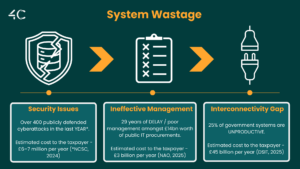Some 25% of government systems are outdated, according to findings from DSIT (2025) – contributing to an estimated cost of £45 billion a year to the taxpayer. If optimised correctly, technology in public sector procurement can enhance transparency, accelerate strategic decision-making, secure sensitive data and soften long-term cost to the taxpayer. The message from the UK government is crystal-clear: a digital-first approach is the essential ingredient for entrenching successful public policy (Gov.UK, 2025). Arguably, obtaining this desired state is the biggest challenge faced in modern-day public sector procurement – in many cases, “clunky” systems can burden the buyer, which in turn will have its downstream impacts on the public sector customer.
Before we can identify the challenges to achieving system optimisation, one must examine the business problem that requires a technology solution. We can structure this analysis under three core functional requirements for any technology: Security, Management and Interconnectivity. We can then contextualise the challenges within a paradigmatic public-sector procurement model:
- Security – Protect data captured through supplier, customer and procurement activity.
- Management – Embed and track at least some element of the Source to Pay (S2P) process.
- Interconnectivity – Sync captured data from ERPs and front-end systems and control transparency where required.
Alarming research from the last 12 months (shown in Figure 1) indicates the risks of not addressing these problem statements.

Figure 1: Three sources of taxpayer losses due to poor system usage.
From the above principles, the implicit challenge is to ensure that the system in question meets the security, management and integration requirements. There is no one-size-fits-all approach, not even within public sector, where in practice (or in an ideal world), ways of working are standardised. But as you might infer from the graphic in Figure 1, the stakes are high and such a challenge requires a thorough matchmaking exercise.
On the topic of Security – organisations working under UK government regulation are held to the highest standards for GDPR data protection and indeed, are at the very top of the priority lists of international threat actors. The recent breach and data leakage from NHS England (BBC, 2024) serves as a reminder that the stakes are greater than ever to keep both customer and employee information secure. Further to this – more “covert” arms-length bodies will have more stringent protection requirements on sensitive procurement data (think critical supplier bank details, high-value contract names, postal addresses on invoices, people’s contact details etc.) – this will have implications for the required threat protection, availability, user access control, SSO design and so forth. A selected software provider should be obliged to provide assurance that they can provide the service expectation in each area, as well as any risk mitigation measures in place to prevent and detect cyber-attacks.
Next, let’s consider Management. The Institute for Project Management has cited approval delays amongst the top five reasons for government project failure. Indeed, approvals are a complex element to systemise. Cross-functional regulated bodies may have distinctly different ways of working, with intricate department structures to map to. An additional layer of complexity arises from the dependency on value, the sourcing route of choice and the associated risk. Each of these variables will determine the number of workflows, the granularity of approval matrices, the level of specification provided within the tasks, the auditability needed (of pipeline) and so forth. The best-in-class software will meet the required capability, within a user interface that is intuitive and straight-forward – one measure of this might be the volume of pop-ups and ‘clicks’ required. This will allow the buying teams to focus on the “doing”.
Finally, on interconnectivity – a need to integrate contract, supplier master, cost centre, payment and even customer data will be vastly common across government and local bodies. This often poses the greatest risk to a failed digital transformation – as one might expect, the output of the system is only as good as the data input. In 2023, the NHS heavily prioritised the development of the Federated Data Platform to integrate patient data within its fragmented care systems. In similar spirit, implementation teams should identify the APIs (Application Programming Interfaces) needed to connect software instances. They should fundamentally consider the intended direction (and frequency) of data flows, as well as the potential volume and type of data fields to be input, stored and reported on. We should also assess the need for communication functionality within the system itself – both internally (think collaborative evaluations) and with prospective suppliers (think tender clarifications).
We should again consider here the impact of procurement regulation reform – integration to the newly designed notice publication system will require a separate process flow. This, in turn, will have its own standards for the above requirements.
To close, technology deployment in public sector procurement is a multi-faceted transformation that must be carefully planned if it is to succeed. It will be helpful to consider the three principles of Security, Management and Interconnectivity provided in this article to structure pre-sales requirements mapping. This should not be seen as a barrier – rather a chance to empower the end user and tap into a savings opportunity worth billions.
If you’d like to open more discussion or have your tech questions answered – please feel free to get in touch with our Partners – Darren Blackburn, Allison Ford-Langstaff and our Head of Digital Innovation – Joe Gibson. We’re always happy to collaborate, share knowledge and support.
Published
March 18th 2025